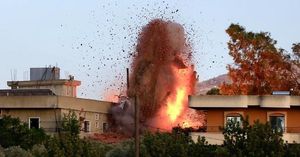OpenAI has officially entered the defense sector through its recent partnership with Anduril Industries, aiming to develop advanced artificial intelligence technologies focused on enhancing military operations. This collaboration marks a significant shift for OpenAI, which had previously maintained strict guidelines prohibiting its technology from military applications.
Anduril Industries, known for its innovative defense solutions, particularly its autonomous surveillance systems deployed along the U.S.-Mexico border, is co-founded by Palmer Luckey, who gained fame as the co-founder of Oculus VR. The company's mission involves integrating cutting-edge technology to bolster national defense, and its collaboration with OpenAI seeks to bolster the capabilities of counter-unmanned aircraft systems (CUAS). These systems aim to improve the detection, assessment, and response processes to swiftly and effectively neutralize aerial threats.
The partnership was announced amid growing concerns about aerial assaults from both unmanned aerial vehicles (UAVs) and traditional manned aircraft, which pose increasing risks to infrastructure and military personnel alike. Brian Schimpf, Anduril's CEO, emphasized the strategic significance of the collaboration by stating, "Our partnership with OpenAI will allow us to utilize their world-class expertise in artificial intelligence to address urgent air defense capability gaps across the world." This reflects broader efforts to modernize military frameworks to keep pace with rapidly advancing technologies.
OpenAI CEO Sam Altman noted, "AI is a transformational technology. With the proper safeguards, it can help protect people, deter adversaries, and even prevent future conflict." This sentiment resonates with the strategic goal of ensuring national security remains competitive against global adversaries, particularly China.
Interestingly, this partnership wasn't just born out of necessity; it aligns with OpenAI's previously articulated mission to improve safety and security. Earlier this year, OpenAI had overlooked its restrictive policies to explore military use, enabling it to engage with contracts like one with the U.S. Department of Defense focusing on cybersecurity and now, offensive and defensive military systems.
But how did we arrive at this juncture? The tech industry has had complex interactions with military applications historically. Google, for example, pulled out of Project Maven, which aimed to bring AI to the military, after employee protests showcased deep-seated ethical concerns. Other companies have also distanced themselves from military applications over fears of ethical backlash, but the dynamics seem to be changing, at least for some firms.
Critics are increasingly vocal about the ethical ramifications of such partnerships. The involvement of Anduril Industries, particularly its controversial surveillance towers, raises questions about the intersection of AI technology with immigration enforcement and civil liberties. The growing scrutiny over surveillance technologies amplifies discussions on privacy, bias, and civil rights.
Despite these tensions, both OpenAI and Anduril maintain their commitment to ensuring their technologies are used defensively. The companies explicitly stated, as mentioned by Altman, future collaborations will adhere to frameworks ensuring democratic values are upheld during military operations.
The rapid evolution and integration of AI technologies point to mounting pressures within the defense sector to do more with less. Enhanced efficiency is seen as necessary to compete globally, prompting companies like Anduril to leverage AI to automate complex tasks and expedite decision-making. OpenAI's expertise is expected to transform data management and analysis for military operations, enabling real-time responses against rapidly shifting aerial threats.
Given this backdrop, the partnership between OpenAI and Anduril Industries can be seen as both groundbreaking and contentious. The collaboration resonates with larger trends of technological integration within military frameworks, potentially setting the stage for future AI-driven innovations on the battlefield. It also hints at what's next for Silicon Valley's engagement with the defense industry: as the line between commercial and military applications continues to blur, the societal conversations around ethics, governance, and accountability grow more complex.
It remains to be seen how public perception will evolve as these technologies continue to develop and integrate within existing defense systems. How this collaboration impacts broader public trust and the potential for these technologies to be used responsibly is likely to capture attention beyond the military and tech circles. For now, the prospects of defending against increasingly sophisticated robotic and drone threats appear to be on the horizon, backed by the strategies Anduril and OpenAI are pursuing together.



